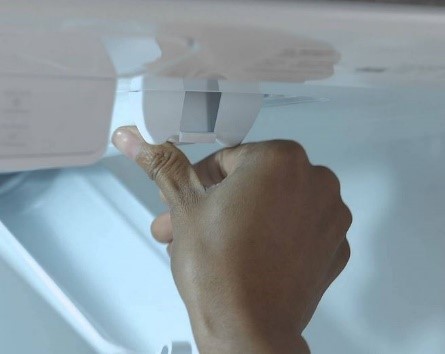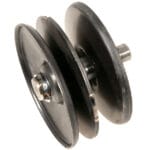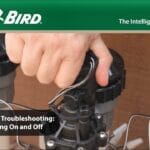To troubleshoot a Bosch refrigerator ice maker, first check water supply and filter. Next, inspect the ice maker’s settings and arm.
Bosch refrigerators are known for their reliability and innovative features, including efficient ice makers that ensure you always have ice on hand for your beverages. Despite their advanced technology, issues can arise, causing the ice maker to malfunction. Troubleshooting the ice maker in your Bosch refrigerator is a straightforward process that can save you time and potentially avoid the need for professional repair.
By ensuring the water supply is intact and the filter is not clogged, you’re taking the first crucial steps. Adjusting the settings and checking the arm position can also resolve common issues. This guide aims to provide homeowners with simple, effective solutions to keep their Bosch refrigerator’s ice maker in optimal working condition.

Credit: denver-appliance.repair
Identifying Common Ice Maker Issues
The heart of any refrigerator is its ability to keep drinks cold and food preserved. But when the ice maker stops working, it can be a significant inconvenience. Understanding common issues with Bosch refrigerator ice makers can save time and stress.
Symptoms Of A Malfunctioning Ice Maker
Several signs indicate a problem with your ice maker:
- No ice production – The ice maker is silent and still.
- Small or malformed ice – Ice cubes are smaller than usual or oddly shaped.
- Leaking water – Puddles form near the refrigerator.
- Strange noises – Clanking or buzzing sounds come from the ice maker.
These symptoms suggest an underlying issue that requires attention.
When To Seek Professional Help
While some ice maker problems are simple fixes, others need an expert. Contact a professional if you notice:
| Issue | Action |
|---|---|
| Continuous cycling | Expert assessment needed |
| Water line problems | Professional repair required |
| Electrical issues | Seek technician help |
For these complex issues, DIY fixes may cause more harm. Rely on certified technicians to restore your ice maker.
Initial Steps Before Troubleshooting
Dealing with a Bosch refrigerator ice maker that’s not working can feel overwhelming. But, before diving into troubleshooting, take the right initial steps. These steps ensure your safety and prepare you for an effective fix. Follow this guide to start the process correctly.
Safety Precautions And Disconnecting Power
Before you begin, put safety first. Always disconnect your refrigerator from its power source. This prevents electric shock and protects the appliance’s electronic components.
- Turn off the refrigerator.
- Unplug from the wall outlet.
- Ensure no power flows to the ice maker.
Gathering Necessary Tools And Materials
Gather the right tools and materials before troubleshooting. You’ll need a few basics to get started:
| Tool/Material | Use |
|---|---|
| Screwdriver | Open panels |
| Towel | Catch drips |
| Flashlight | See in dark spaces |
- Make a list of needed items.
- Check if you have everything.
- Keep them within reach.
Assessing The Water Supply Line
Is your Bosch refrigerator’s ice maker not working? The problem might be with the water supply line. This line brings water to your fridge to make ice. Let’s check this line together.
Checking For Kinks And Leaks
First, we need to find the water supply line. It’s a tube that runs from the wall to your fridge. Once you find it, look for any bends or twists. These are called “kinks.” Kinks can stop water from flowing. Make sure the line is straight and has no kinks.
Next, check for leaks. A wet spot or a small puddle near the line means there’s a leak. Leaks can cause low water pressure. This makes your ice maker work poorly.
Water Pressure Evaluation And Adjustment
Your ice maker needs the right water pressure to work well. Too little pressure, and it can’t make ice. Most ice makers need at least 20 psi (pounds per square inch) of water pressure.
- Check the pressure: You can use a water pressure gauge. Attach it to the water supply line. It will show you the pressure level.
- Adjust the pressure: If the pressure is too low, you might need a plumber to fix it. They can adjust the pressure to make your ice maker work right.
By following these steps, you can make sure your Bosch refrigerator’s ice maker gets the right amount of water. A happy ice maker means more ice for you!
Evaluating The Filter And Inlet Valve
Is your Bosch refrigerator ice maker not working? It may be time to check two critical components: the water filter and the inlet valve. These parts play a vital role in ice production.
When To Replace The Water Filter
A fresh water filter ensures clean ice. Replace it every six months or after filtering 200 gallons.
- Check the manual for your specific model’s filter type.
- Notice poor ice production? Change the filter.
- Water tasting off? New filter time.
Testing The Inlet Valve For Functionality
The inlet valve controls water flow. A malfunctioning valve can halt ice production.
- First, disconnect the fridge from power.
- Locate the valve, usually at the back.
- Inspect for cracks or damage.
- Use a multimeter to check for continuity. No continuity? Replace the valve.
Remember, always prioritize safety when handling appliances.
Ice Maker Mechanism Inspection
A Bosch refrigerator’s ice maker is a modern convenience. Yet, it may stop working. Regular checks keep it running well. This guide helps inspect the mechanism.
Verifying The Ejector Blades
Ejector blades push ice out. They must move freely. If stuck, they need cleaning. Ice clumps can jam them.
- Turn off the fridge.
- Remove the ice bin.
- Check for blockages.
- Clear any stuck ice.
Test the blades after cleaning. Turn on the ice maker. Watch the cycle. The blades should turn.
Examining The Ice Maker Mold Thermostat
The thermostat controls the ice mold temperature. It triggers the cycle. A faulty thermostat stops ice production.
- Locate the thermostat.
- It sits near the ice mold.
- Use a multimeter to test it.
Replace the thermostat if defective. The ice maker should work after.
Electronic Controls And Sensors
The Electronic Controls and Sensors in your Bosch refrigerator play a crucial role. They manage the ice maker’s operation. When these controls have issues, the ice maker may stop working. Let’s explore how to reset the ice maker and troubleshoot these electronic parts.
Resetting The Ice Maker
Resetting the ice maker is a simple fix. Follow these steps:
- Turn off the fridge at the power source.
- Wait for about 2 minutes.
- Turn the power back on.
- Wait 24 hours for the ice maker to start again.
This process can fix minor glitches. If the ice maker doesn’t work, more steps are needed.
Troubleshooting Control Boards And Sensors
Control boards and sensors are the brain of your ice maker. They need checks if resetting doesn’t fix the issue.
- Check for error codes on the display panel. Refer to the user manual for meanings.
- Inspect the sensor for dirt or blockage. Clean gently with a soft cloth.
- If errors persist, the control board might need a professional check.
A professional can diagnose and replace faulty parts safely. This ensures your ice maker works smoothly again.
Addressing Freezing And Temperature Issues
Many users face ice maker issues with Bosch refrigerators. Let’s dive into common problems and fixes.
Regulating Freezer Temperature
Correct temperature settings keep the ice maker running smoothly. Follow these steps:
- Check the control panel.
- Set the freezer between 0°F and 5°F.
- Wait 24 hours.
- Check for proper ice production.
Thermometers help monitor freezer temperatures. Place one inside and adjust settings as needed.
Resolving Ice Clumping And Overproduction
Ice clumps and overproduction are common. Here’s what to do:
- Empty the ice bin.
- Check for stuck ice or debris.
- Clean the bin and chute.
- Reduce the ice maker’s production if needed.
Regular maintenance prevents future issues. Clean and check the ice maker monthly.

Credit: www.youtube.com
Maintenance Tips For Long-term Performance
Maintaining your Bosch refrigerator ice maker is key for optimal performance. Follow these tips to ensure it runs smoothly for years.
Regular Cleaning Recommendations
Clean your ice maker regularly to maintain its efficiency. Here’s a simple guide:
- Turn off the ice maker and remove the ice bin.
- Wipe the interior with a soft cloth and warm water.
- Clean the ice bin with soapy water and let it dry.
- Use a mild detergent for stubborn stains.
- Reassemble and restart the ice maker after cleaning.
Preventive Measures To Avoid Future Issues
Prevention is better than cure, especially with appliances. Here’s how to prevent ice maker issues:
- Check water filters every six months and replace if necessary.
- Ensure water lines are not kinked or blocked.
- Keep your freezer at the right temperature for optimal ice production.
- Avoid overfilling the ice bin to prevent jamming.
Professional Repair Or Replacement
Is your Bosch refrigerator ice maker acting up? You might ponder whether to fix it or get a new one. Let’s explore your options.
Deciding Between Repair And Replacement
Think about a few things when choosing. How old is the fridge? If it’s new, repairing might make sense. Is it often breaking down? Then, a new ice maker could be better. What’s the cost difference? If repairs are expensive, replacement might be the smarter choice.
Finding Qualified Technicians For Bosch Appliances
Trust experts with your Bosch fridge. Look for certified technicians who know Bosch products well. They should offer a warranty for their work. Check reviews online to ensure they have happy customers. A skilled technician can make your ice maker work like new again.

Credit: avivservicetoday.com
Frequently Asked Questions
Why Is My Bosch Ice Maker Not Working?
Troubleshooting a Bosch refrigerator’s ice maker begins with checking the water supply line for kinks or blockages and ensuring the freezer is at the correct temperature, typically below 0°F (-18°C).
How Do I Reset My Bosch Ice Maker?
To reset your Bosch ice maker, turn off the ice maker, wait for a few minutes, and then power it on again. Alternatively, consult your user manual for model-specific instructions.
Can A Bosch Ice Maker Be Repaired?
Yes, Bosch ice makers can often be repaired. Common issues like clogs, faulty water inlet valves, or malfunctioning sensors can be addressed by following the user manual or contacting a professional.
What Causes Bosch Ice Maker Leaks?
Leaks in a Bosch ice maker are commonly caused by a clogged or frozen water line, an improperly seated water filter, or a faulty water inlet valve that may need replacement.
How Often Should I Clean My Bosch Ice Maker?
Cleaning your Bosch ice maker every 3 to 6 months is recommended to maintain optimal performance and hygiene, ensuring the production of clean and clear ice.
Where Can I Find Bosch Ice Maker Parts?
Bosch ice maker parts are available from Bosch’s official website, authorized dealers, and online retailers. Ensure you have the correct model number for compatibility.
Conclusion
Navigating the quirks of a Bosch refrigerator’s ice maker need not be daunting. Our troubleshooting guide paves the way for hassle-free fixes. Remember, routine maintenance goes a long way. Should complexities arise, professional help is a call away. Keep your cool, and your Bosch unit will follow suit.




